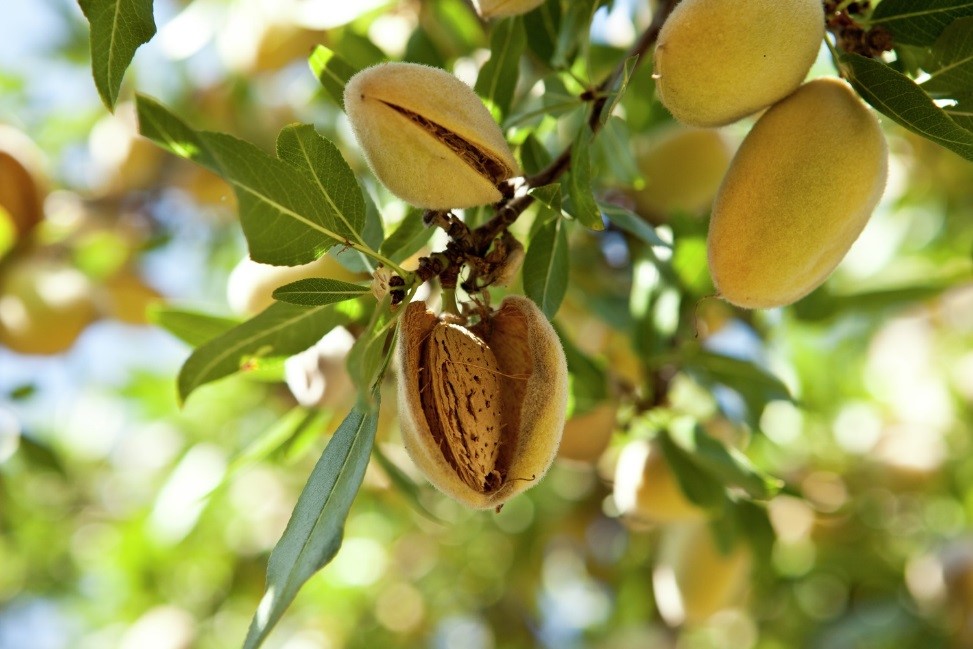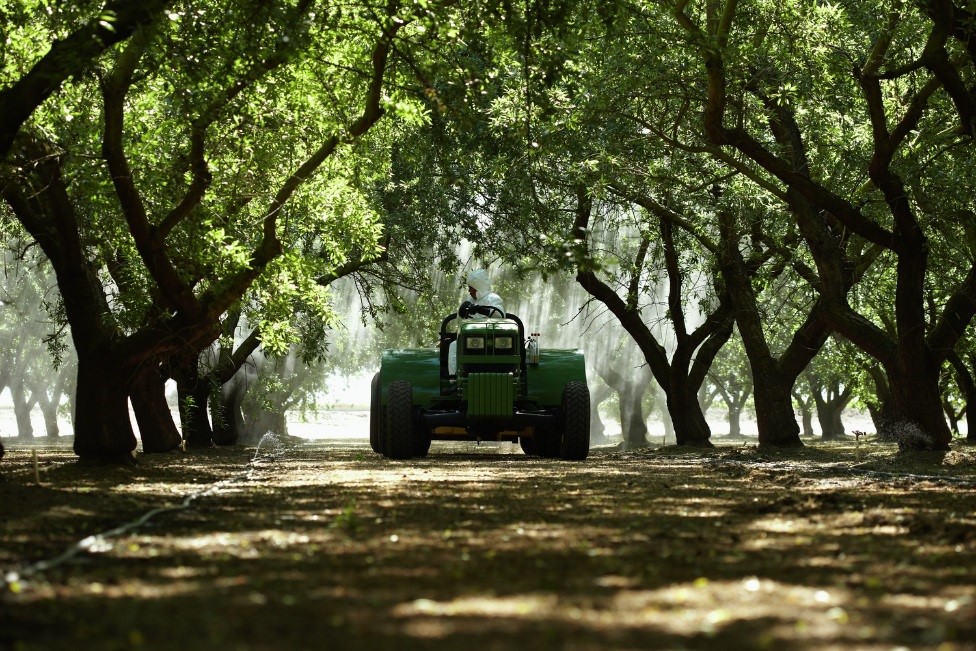Almond trees across California have progressed through bloom and are making strides toward later growth stages. With this maturing crop comes a new focus – protecting almond trees and crop from troublesome in season pests.
Successful pest management using pesticides requires proper application, striking a balance between efficacy and efficiency. When done correctly, not only can pest control be improved, but growers can also see reductions in waste of product, drift potential and less overall environmental impact. 
“The benefits of proper and effective application are manifold,” said Bob Curtis, director, agricultural affairs, Almond Board of California (ABC). “That’s what makes preparation for application so important.”
So, what can growers do to ensure they’re ready for the season’s pesticide applications? The work begins before moving equipment into the orchard to spray.
Calibration is key
Calibration is an important step in preparing for application. It involves ensuring spray rigs are ready to deliver the PCA’s recommendation. Calibration basics are covered in the UC publication "The Safe and Effective Use of Pesticides, 3rd Edition," Publication Number 3324.
However, without the right sprayer setup, spray accuracy and crop protection efficacy may decline and can have a higher risk of offsite movement.
“To make things trickier, there’s a timing element to setting sprayers properly,” said Curtis. “What’s right for one part of the season may not be right for another.”
For instance, in a particular orchard, 50-75 GPA at 3 mph might deliver good coverage at bloom, but effective hull split coverage could require 150-200 GPA at 2 mph.
This difference in effective and efficient spraying setups comes from varying densities of the tree canopy, depending on the growth stage. The less dense canopies that exist early in the season don’t slow spray movement through the canopy as much as later-season conditions – like those present at hull split. Those dense canopies, with clusters of nuts pulling shoots and branches down into thick tangles, limit spray movement to  harder to reach areas in the upper canopy at ground speeds that delivered effective spray coverage early in the season. Growers are advised to calibrate sprayers at least once a year, but the best strategy includes a calibration for early season conditions (dormant through bloom) and again once full leaf out occurs. If only one calibration is feasible, however, the best timing is at full canopy conditions. Dr. Franz Niederholzer (UCCE Colusa and Sutter/Yuba Counties) notes that this timing is the most important preparation for hull split spraying, the toughest spray job in almond production.
harder to reach areas in the upper canopy at ground speeds that delivered effective spray coverage early in the season. Growers are advised to calibrate sprayers at least once a year, but the best strategy includes a calibration for early season conditions (dormant through bloom) and again once full leaf out occurs. If only one calibration is feasible, however, the best timing is at full canopy conditions. Dr. Franz Niederholzer (UCCE Colusa and Sutter/Yuba Counties) notes that this timing is the most important preparation for hull split spraying, the toughest spray job in almond production.
Maximizing coverage
The end goal of any pest management application is uniform delivery of the labeled pesticide rate to the target, and for many pesticides, effective pest control requires good spray coverage. Almond Board funded and other research shows that proper sprayer speed and spray volume are often overlooked and as a result, many top halves of orchards can be poorly covered. Typical ground sprayers more effectively cover the bottom half of trees, leaving the top half more vulnerable to pests. For example, with hull split sprays, research spearheaded by USDA ARS entomologist, Dr. Joel Siegel, has shown that navel orangeworm (NOW) spray efficacy declines significantly in the upper canopy due to the drop-off in spray coverage above 16 feet. Studies led by Brad Higbee, at Wonderful Orchards and now with Trécé, Inc., showed only 15% spray coverage on nuts at 18-20 feet, compared to 76% at 6-8 feet.
“One of the biggest culprits in reduced spray coverage and pest control at full canopy is excessive speed,” said Curtis. “It’s important to drive slow and give the air from the sprayer time to reach the tree tops.” Curtis explains that simply increasing the spray volume per acre will not move the air and active ingredient to the target – the spray droplets go where the air from the sprayer’s fan goes. Driving slow gives the air from the sprayer fan time to reach the tree tops. This is a balancing act between too much and too little. There must be enough air to carry the spray to the target, but blowing spray above the canopy can waste it as drift. Even a minor change in ground speed can have significant impact on pest control, especially in tree tops Siegel’s and Dr. Ken Giles’ (UC Davis) research demonstrated that a slight speed increase from 1.8 to 2.4 mph reduced NOW larval control by 8% in the upper canopy 14 days after spraying, while there was no difference in pest survival in the lower canopy between the two speeds.
Checking for proper setup
After taking time to ensure equipment is ready for application, delivering the desired gallons per acre targeting the canopy, growers can employ a few tests to validate their efforts and confirm delivery to the target.
- Sprayer air speed and impact on coverage: Proper sprayer speed is the most critical adjustment in effective spraying. Use flagging tape to check for proper sprayer ground speed, the fastest speed that still delivers spray just through the tops of the tallest trees. Position a PVC pipe with 12-18” of flagging tape tied to its end just above the top of the canopy to show if adequate airflow is reaching there. As the sprayer drives by with the fan on, if the flag flaps out at or about 45-90 degrees from the vertical, the air flow and sprayer speed is in the right range. If the flag raises to 90-180 degrees from vertical, the air flow is too fast and the sprayer speed too slow. But if the flag just flutters weakly (below 25 degrees off vertical), the air flow is too low and the sprayer speed too fast. Adjust sprayer speed and recheck until the flagging movement is in the right range (45-90 deg off vertical).
- Coverage: With the proper sprayer ground speed set, check spray coverage either with water sensitive paper, Kaolin clay or just clean water. Run the sprayer through an orchard row at normal operating settings and spray flow, while ensuring to shut off or deflect any air not directed into the tree. Check the coverage throughout the canopy, but especially in the hard-to-cover areas toward the tops of the trees. Adjust ground speed and nozzle number, selection and location on the sprayer as needed to deliver spray uniformly through the canopy.
Growers and applicators have multiple resources to help navigate through equipment setup and calibration. PCAs, university experts and consultants from equipment companies can offer additional input and counsel. Keep good records for sprayer settings and calibration for each orchard. This makes future calibration(s) easier. Additionally, the Almond Board continues to invest in research on improving spray efficacy, and the findings are routinely presented at The Almond Conference.


